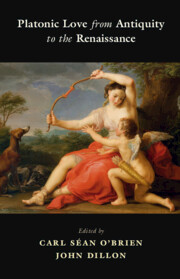Book contents
- Platonic Love from Antiquity to the Renaissance
- Platonic Love from Antiquity to the Renaissance
- Copyright page
- Contents
- Acknowledgements
- Notes on Contributors
- Introduction
- Part I Love in Plato
- Part II Development of Platonic Love in Antiquity
- Chapter 5 Plutarch
- Chapter 6 Love in Plotinus’ Thought
- Chapter 7 A Platonist ‘Ars Amatoria’
- Chapter 8 Desire and Love in Augustine
- Part III Love and Metaphysics during the Middle Ages
- Part IV Platonic Love during the Renaissance
- Bibliography
- Subject Index
- Index Locorum
Chapter 8 - Desire and Love in Augustine
from Part II - Development of Platonic Love in Antiquity
Published online by Cambridge University Press: 25 August 2022
- Platonic Love from Antiquity to the Renaissance
- Platonic Love from Antiquity to the Renaissance
- Copyright page
- Contents
- Acknowledgements
- Notes on Contributors
- Introduction
- Part I Love in Plato
- Part II Development of Platonic Love in Antiquity
- Chapter 5 Plutarch
- Chapter 6 Love in Plotinus’ Thought
- Chapter 7 A Platonist ‘Ars Amatoria’
- Chapter 8 Desire and Love in Augustine
- Part III Love and Metaphysics during the Middle Ages
- Part IV Platonic Love during the Renaissance
- Bibliography
- Subject Index
- Index Locorum
Summary
Augustine is rightly regarded as one of the major figures of Christianity. Through him Platonist and Neo-Platonist philosophy was appropriated in the new religious context and there is hardly another thinker of the early Christian tradition who can better illustrate Nietzsche’s remark on Christianity as a Platonism for the people than Augustine. Things are, however, more complicated than Nietzsche suggests. As Étienne Gilson has showed, there is a strong tension between medieval Aristotelianism and the necessity to respect the early foundational authority, which Saint Augustine incontestably was. Aquinas has in this sense a quite complicated relation to his predecessor. In order to understand what is at stake in Augustine’s understanding of the biblical message of love, heavily influenced by Paul, it is important not only to describe the Neoplatonist roots of Augustine’s thought, but also to take the wider ancient context into account – and in this way arrive at a more complete picture of the historical and intellectual setting. The modification Augustine brings to the Aristotelian conception of the soul is hereby particularly revealing. A closer study of the relation between desire and love can shed some light on this highly significant constellation.
- Type
- Chapter
- Information
- Platonic Love from Antiquity to the Renaissance , pp. 133 - 150Publisher: Cambridge University PressPrint publication year: 2022
- 1
- Cited by

